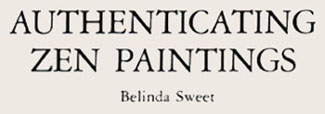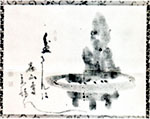
THE
JAPANESE often refer to the calligraphy and paintings of Zen monks as Bokuseki
(ink traces). And that is just
what they are: traces left in ink
that somehow capture the spirit and Zen realization of monks who painted them,
won after long years of rigorous training.
It
is perhaps for this reason that these paintings, although seldom “pretty”
in decorative sense, have a haunting intensity, even when they are amusing,
that I have not found in any other school of painting.
Forgeries
of Zen paintings are not quite the problem that forgeries are with some other
types of painting. Until recently
Zen paintings have not been widely collected, so from a monetary standpoint
the reward for the forger was not that great.
This is not to say, however, that they have not been copied.
Indeed, there are many fakes. Since
Hakuin (1685-1768) was the most famous of the Zen artists, and therefore the
most likely to be copied, I will use one of his genuine works as an example of
the system I use for authentication.
|
|
In
determining the authenticity of a Zen painting, the two main factors I take
into consideration are the seals and the brushwork. |
What I look for are
slight discrepancies in the proportion of the lines within the seal, and the
lack of characteristic indentations in the outline.
To
complicate matters further it should be noted that throughout his painting
career, a Zen monk may have used many different seals (Hakuin, for example,
used about forty), some of which had only minor differences.
So it is important to have photographs as well of every seal an artist
was known to have used. Then, if
a variant is found, a mistake in judgment is less likely to be made.
Since
few examples of seals are published, I have found it invaluable to photograph
and catalogue Zen monks’ seals in order to build a backlog of information
that will be available when needed.
Before
assuming that a seal I have not seen before is genuine, I consider whether the
other seals on the painting are authenticated examples.
If even one is absolutely correct, it validates the others, which,
through further study, are bound to come up again.
As there are many Zen painters, sometimes all seals on a painting are
new to me, and this is one of the reasons I have found it essential to
familiarize myself with as many examples as possible of any artist’s
brushwork, which changed of course with age and deepening Zen insight.
Even
if the brushwork seems completely in accord with the artist’s style, it is
still wise to reserve final judgment until the seals in question are found
repeatedly on works whose brushwork is beyond reproach.
|
Naturally,
reference books are helpful in determining style, but I have found them only a
beginning, so in addition I photograph every Zen painting I can. (For example, using both these sources, I have been able to
gather photographs of over nine hundred examples of Hakuin paintings, both
genuine and forged.) |
|
Now
we have come to a very important factor:
is the brushwork similar enough to have been made by the same hand? Keeping in mind that there are natural variations in
brushwork due to mood, age, etc., I study all parts of the painting carefully,
as a forger may have had the knack of reproducing a certain stroke quite well,
but give himself away with some minor detail.
Sometimes it is necessary to come back to a painting many times or get
another opinion before I am completely satisfied.
The
study of brushwork and style is very important for another reason as well.
Sometimes artists were known to lend their seals—so even if the seal
is genuine, we cannot be certain the work itself is genuine without carefully
studying the brushwork.
For
further evaluation the following must be taken into consideration:
1)
Is it a good example of this subject? How does the overall composition
compare? (Even master calligraphers had their off-days and were capable of
producing quite mediocre work.)
2)
Is the poem the same on all of the gathered works? Since Hakuin and
other Zen monks often used the same poem for each subject, a variation here is
not necessarily bad; in fact it can be quite good, as rarity naturally
increases the value.
3)
How does the ink tone compare? If it is gray rather than black, was it
deliberate on the artist’s part, or has the ink faded from being washed in
repeated remountings?
4)
Does the paper or silk on which the painting was done have some age?
Are there crack lines, or worm-holes? Can it be repaired? Sometimes an
excellent mounter can work a seeming miracle.
It should be noted that Zen paintings are not usually found in good
condition. They were almost
always given to other monks or ordinary people, and so did not have the care
lavished on them as did works commissioned by the wealthy from professional
artists. So the usual standards
of painting condition cannot be applied in this case.
There is, however, the occasional exception, and it is thrilling to
find such a piece.
5)
Is the size either unusually large or small for the subject? If the
measurements of comparison works are not available, a good estimate can be
made from the size of the seals relative to the overall size of the subject.
An unusual size can make a work of greater interest.
6)
Does it seem to have been cut down? This can be ascertained by
comparing the composition and the nearness of seals to the edges of the paper.
7)
How rare is the subject? This is a further reason I find it important
to have photographs of as many examples as possible of a monk’s works. Of
course, something rare and wonderful is quite capable of turning up at any
time.
8)
To me, the last and probably most important factor is what is the
overall feeling of this painting? Do you like it? If it does not draw you in
some important and indefinable way, then no matter how good it is, it is just
not your painting. In my opinion,
collecting is also a creative act. Taste
is expressed by the painter through his brushwork and composition, and by the
collector through what he chooses to add to his collection. It is part of the sum total of a person’s experiences,
values, and who he or she is as a unique example of the human race.
|
|
After
having thoroughly studied the work itself, we should have a look at the wooden
box in which it is usually stored when not displayed. These boxes are not always signed, but if they are they can
add a lot of interest to a piece. Bokuseki
boxes were almost never signed by the artists themselves.
Sometimes they were signed by former owners, who for reasons already
explained were seldom famous collectors.
Nevertheless, this can add a sense of history to a painting. Boxes
are also signed by "experts": specialists in Zen paintings, museum
curators, other Zen monks, etc. In
this case the box is intended as a guarantee of its contents.
Although this is an interesting theory, I find that it must be taken
with a grain of salt. At some point the box may have been separated from its
original contents and another painting substituted.
Even if the connoisseurship of the person signing the box is excellent,
it is always possible that the signer was more concerned about the feelings of
the owner than his own reputation as an expert. Taking these things into consideration, I regard an
interesting box as just that, and not an absolute guarantee of the contents. |
If
signed, the box usually has the subject and artist on the outside cover, and
the name of the signer and sometimes the date of the signing on the inside
cover.
The
box in which this painting is kept is signed; the outside cover reads, Zen
Master Hakuin, Bokuseki (ink traces) Ishiyamadera, Bon san wa (the first line
of the poem in this painting). On
the inside we are informed that this box was signed by Sokaku at the age of
82, January 16th, 1973. As Sokaku
was formerly head priest of Shoin-ji, the temple where Hakuin was initiated
and spent most of his life, the box does add an appealing sense of historical
continuity to this painting.
Naturally
every serious student of Bokuseki has developed his own particular method for
authentication; however, the procedure I have described has worked quite well
for me. I am finding that the
more I study Zen works, and the lives and circumstances of the monks who made
them, the more fascinated I become, and know that I have only begun truly to
understand their deeper meanings.


